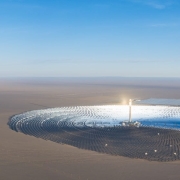Differences between photovoltaic and solar thermal energy
The sun is the main provider of energy. The development of the renewable energy market is largely based on that fact. Most of the green technologies in operation today collect solar energy, directly or indirectly. The direct solar energy source consists of solar rays that reach the atmosphere and these can be collected using two different technologies: photovoltaic solar energy and solar thermal systems.
Technology
The fundamental difference between photovoltaic solar energy and solar thermal energy can be found in their operating principles. Photovoltaic solar energy is based on the photovoltaic effect, whereby a photon (hitting a surface made of a special material generates the release of an electron. Solar thermal energy, on the other hand, uses sunlight to heat a fluid, which may be water but not necessarily.
The photovoltaic effect is only produced in a small number of materials, called semiconductors (such as silicon – monocrystalline, polycrystalline and amorphous – and cadmium telluride), which, after specific chemical procedures, allow the generation of an electric current when exposed to the light. These semiconductors are in the form of thin layers that make up the central element of solar cells, the basic element of a solar photovoltaic system, which produces a direct current.
Solar cells are built into larger structures known as solar panels, where desired current and voltage values can be achieved. For systems connected to the grid –which represent a large part of the market– it is necessary to use an inverter to convert the direct current generated by the cells into alternating current, which is the one used in the network.
The principle of operation of solar thermal systems is much less sophisticated, but just as useful for the generation of consumable energy as the photovoltaic effect. It consists of the direct heating of water, or other fluids, by means of sunlight. This energy conversion takes place in different devices depending on the range of temperatures to which the fluid is heated.
Types of photovoltaic solar panels
Solar panels are mainly made of silicon. The purity of this material, as well as the manufacturing processes, mark the quality and performance of solar panels. There are three main types of solar panels:
- Monocrystalline solar panels
They have a yield close to 24%, the theoretical limit being 25%. The purity of the silicon that forms it is higher and therefore they ensure higher yields, although in turn they have a higher cost.
- Polycrystalline solar panels
They are cheaper than monocrystalline but are less efficient. They have an approximate 18% yield due to lower purity in construction material. Despite having a lower performance than monocrystalline panels, the losses when working at high temperatures are lower.
- Amorphous solar panels
They are half the performance of a monocrystalline panel, and their performance deteriorates more rapidly over the years. They are not recommended for large installations.

Types of solar thermal energy
- Low temperature solar thermal energy
This energy is produced by low-temperature collectors, which allow temperatures of up to 65º C to be reached through heat absorbers. This energy in the form of heat is used for domestic use, allowing them to have solar heating.
- Medium temperature solar thermal energy
Medium temperature collectors are identified with which temperatures of up to 300ºC can be generated. These collectors work by concentrating energy through mirrors, so they can only work in places with high amounts of direct radiation.
- High temperature solar thermal energy
They use high-temperature collectors, which allows the generation of temperatures above 500º C, allowing the generation of solar thermal energy through steam turbines. Some of the techniques used to reach these temperatures consist of concentrating solar energy using mirrors.
Utilization
Regarding the use of these technologies, in power plants photovoltaic and solar thermal systems share the production of electricity as their objective. While photovoltaic systems generate this electricity directly from solar energy, solar thermal systems heat a fluid (water, oil, etc.) that makes a steam engine, gas turbine or similar work. That electricity is transferred to the grid, as alternating current and with the required voltage value.
In the case of photovoltaic plants, the capacity of the largest ones is above 500 MW, while that of the largest thermal plants is less than 400 MW. Both types are experiencing rapid growth in many parts of the world, with even more under construction and in planning.









